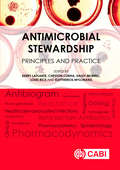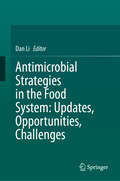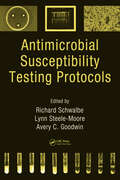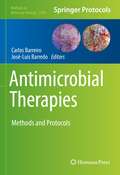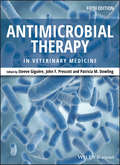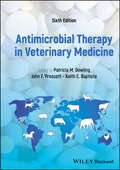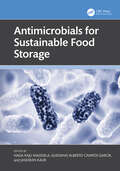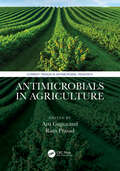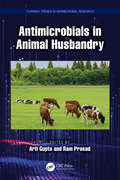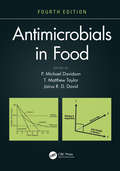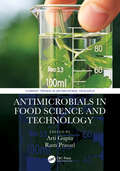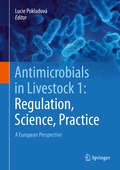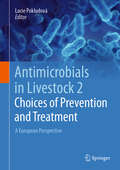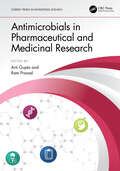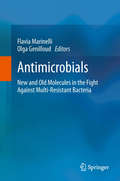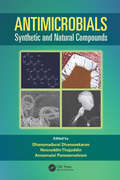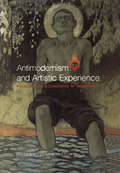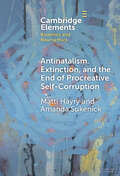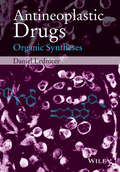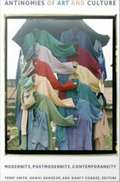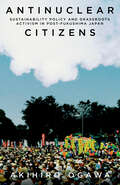- Table View
- List View
Antimicrobial Stewardship: Principles and Practice
by Eleftherios Mylonakis Kerry L. Laplante Cheston B. Cunha Haley J. Morrill Louis B. RiceIn an age where antimicrobial resistance amongst pathogens grows more prevalent, particularly in the hospital setting, antimicrobial stewardship is an evidence-based, proven measure in the battle against resistance and infection. This single comprehensive, definitive reference work is written by an international team of acknowledged experts in the field. The authors explore the effective use of coordinated antimicrobial interventions to change prescribing practice and help slow the emergence of antimicrobial resistance, ensuring that antimicrobials remain an effective treatment for infection. Amongst the first of its kind, this book provides infectious disease physicians, administrators, laboratory, pharmacy, nursing and medical staff with practical guidance in setting up antimicrobial stewardship programs in their institutions with the aim of selecting the optimal antimicrobial drug regimen, dose, duration of therapy, and route of administration.
Antimicrobial Strategies in the Food System: Updates, Opportunities, Challenges
by Dan LiIn 2023, world hunger and food insecurity looms as present as ever. The threat of foodborne illness is also alive and well, as 1 in 10 people fall ill each year from the consumption of contaminated food. Meanwhile, thirty percent of all the food produced on our planet is lost or wasted, due in large part to spoilage. In the face of these realities, as well as those of climate change, population growth, ecosystem degradation and increasing resource scarcity, the dire need for a more sustainable global food system can no longer be ignored. Consumers are not only more invested in sustainability than ever, but also more health conscious. Recent years have thus seen a proliferation of alternative antimicrobial strategies, all aiming to mitigate the risks inherent in developing new production systems while striving for longer-lasting food products. Antimicrobial Strategies in the Food System: Updates, Opportunities, Challenges elucidates the established methods of this rapidly evolving field and introduces cutting-edge technologies such as urban/indoor agriculture. With an emphasis on detailing each step in the chain of food production, the text demonstrates how safety begins with primary production, from agriculture to aquaculture, and remains paramount through to packaging and handling. Developing informed and updated definitions of the terms &“natural&” and &“sustainable,&” this book addresses the fragilities of the current food system and establishes possibilities for future research and practice.
Antimicrobial Susceptibility Testing Protocols
by Richard Schwalbe Lynn Steele-Moore Avery C. GoodwinThe clinical microbiology laboratory is often a sentinel for the detection of drug resistant strains of microorganisms. Standardized protocols require continual scrutiny to detect emerging phenotypic resistance patterns. The timely notification of clinicians with susceptibility results can initiate the alteration of antimicrobial chemotherapy and
Antimicrobial Therapies: Methods and Protocols (Methods in Molecular Biology #2296)
by José-Luis Barredo Carlos BarreiroAntimicrobial resistance will become a global health threat since antimicrobial treatments continue at the forefront of the defense against microbial infections. To respond to the issue, this detailed book explores vital methodologies currently in use to advance our understanding of antibiotic issues and answer the worldwide demand for novel antibiotics therapies. Beginning with a review chapter that guides the reader through the worldwide demand for novel antibiotics therapies, the volume continues with sections covering new screening procedures and environmental sources, advances in analytical, microbiological, and biotechnological methodologies, antibiotic production and antibiotic resistances, as well as considerations of drug trials and clinical concerns regarding multi-resistant patients. Written for the highly successful Methods in Molecular Biology series, chapters include introductions to their respective topics, lists of the necessary materials and reagents, step-by-step, readily reproducible laboratory protocols, and tips on troubleshooting and avoiding known pitfalls. Authoritative and practical, Antimicrobial Therapies: Methods and Protocols provides a reference source for health, laboratory, and industrial professionals, as well as for graduate students in a number of bio-sanitary disciplines, including medicine, nursery, biotechnology, veterinary, microbiology, genetics, molecular biology, nutrition, farming, and more.
Antimicrobial Therapy in Veterinary Medicine
by John F. Prescott Steeve Giguère Patricia M. DowlingThe Fifth Edition of Antimicrobial Therapy in Veterinary Medicine, the most comprehensive reference available on veterinary antimicrobial drug use, has been thoroughly revised and updated to reflect the rapid advancements in the field of antimicrobial therapy. Encompassing all aspects of antimicrobial drug use in animals, the book provides detailed coverage of virtually all types of antimicrobials relevant to animal health. Now with a new chapter on antimicrobial therapy in zoo animals, Antimicrobial Therapy in Veterinary Medicine offers a wealth of invaluable information for appropriately prescribing antimicrobial therapies and shaping public policy.Divided into four sections covering general principles of antimicrobial therapy, classes of antimicrobial agents, special considerations, and antimicrobial drug use in multiple animal species, the text is enhanced by tables, diagrams, and photos. Antimicrobial Therapy in Veterinary Medicine is an essential resource for anyone concerned with the appropriate use of antimicrobial drugs, including veterinary practitioners, students, public health veterinarians, and industry and research scientists.
Antimicrobial Therapy in Veterinary Medicine
by John F. Prescott Patricia M. Dowling Keith E. BaptisteProvides a comprehensive, fully updated reference book to the general principles and clinical applications of antimicrobials in veterinary medicine The sixth edition of Antimicrobial Therapy in Veterinary Medicine has been updated to reflect advances in the field, including new international contributors and a broader global outlook. It includes extensive knowledge of both general principles of mechanisms of antimicrobial drug action including specific classes of antimicrobial agents, as well as chapters dedicated to antimicrobial drug use in a wide range of animal species. As antimicrobial resistance increases as a major global issue in both human and animal health, this book’s renewed focus on antimicrobial stewardship in companion animals, in food animals, and on global aspects keeps it at the forefront of this vital field. The Sixth Edition of this classic text offers: Updates to every chapter, reflecting new developments and research, with a complete examination of the issues associated with antimicrobial resistance A comprehensive reference for all aspects of antimicrobial use in veterinary medicine, encompassing theory and practice A global perspective on antimicrobial therapy, with more international content than previous editions A stronger emphasis on antimicrobial stewardship, with practical guidance for prescribing antimicrobial drugs A companion website with tables and figures from the book available for download Antimicrobial Therapy in Veterinary Medicine is an essential and accessible resource for veterinarians, veterinary students, scientists, and professionals in veterinary medicine and antimicrobial research and stewardship.
Antimicrobial and Antiviral Materials: Polymers, Metals, Ceramics, and Applications
by Suchart Siengchin Sanjay Mavinkere Rangappa Peerawatt Nunthavarawong Mathew Thoppil-MathewEmerging microbial and viral infections are a serious challenge to health, safety, and economics around the world. Antimicrobial and antiviral technologies are needed to disrupt the progression and replication of bacteria and viruses and to counter their rapidly evolving resistance. This book discusses recent developments in materials science and engineering in combating infectious diseases and explores advances in antimicrobial and antiviral materials, including polymers, metals, and ceramics and their applications in the fight against pathogens. Features • Covers progress in biomimetic antimicrobial and antiviral materials and antimicrobial/antiviral bulk materials and coatings • Describes modern methods for disinfection of biomedical materials against microbial and viral infection resistance, especially for depressing novel coronavirus (COVID-19) • Details methods to improve material properties to have a longer service life in combating infection • Emphasizes chemical, physical, mechanical, tribological, and antimicrobial/antiviral properties • Offers current and future applications of emerging antimicrobial/antiviral technologies This book will be of interest to materials researchers and industry professionals focusing on antimicrobial and antiviral applications.
Antimicrobial/Anti-Infective Materials: Principles and Applications
by Gurusamy Manivannan Samuel P. SawanAs our consciousness of microbes increases, it appears that our desire to control our interactions with germs also increases in proportion. This is clearly demonstrated by examining the incredible growth in the number and sales volume of consumer products with antimicrobial claims. In the medical field as well, there is much interest in the use of
Antimicrobials for Sustainable Food Storage
by Naga Raju Maddela Jaskiran Kaur García, Gusdanis Alberto CamposFinding natural substances is worthwhile in food preservation. The principal motivation behind this edited volume, Antimicrobials for Sustainable Food Storage, is to collect and present widespread knowledge in the domain of sustainable food ingredients with antimicrobial properties. The book consists of two sections. The first section of this volume is about food ingredients as antimicrobials, and the second section discusses the recent advances in the applications of food ingredients.Interplay of various environmental factors favors the growth of different microorganisms during the food preservation process. Growth of undesirable microorganisms negatively influences the taste, smell, color, and texture of food. Therefore, sustainable food preservation is a challenging issue. Though several chemicals have emerged, inevitable health effects are commonly encountered by food preserve chemicals.Microbial products (nisin, enterocin, pentosin, sakacin, and pediocin) have immense importance in prolonging the shelf life of food substances by controlling food spoilage and pathogenic microbes. Yeasts and cyanobacteria are also potential candidates in the supply of food ingredients with significant antimicrobial properties. However, limited awareness of antimicrobials as food ingredients and the unavailability of a single source of the latest insights on such food ingredients in one place led to the motivation to produce this work.Key Features: Provides insights on natural antimicrobials in food preservation Underlines the importance of sustainable food packaging Offers knowledge on emerging trends in antimicrobial-based food storage Diverse applications are covered in different chapters. This book covers various antimicrobials as food preservatives, such as metabolites, natural products, essential oils, nanomaterials, L-arginine, polyphenols, phaeophyceae, and horchata. There are also chapters that focus on the applicability and prospective studies of essential oils, edible biofilms, biodegradable antimicrobials, and nanostructured lipid carriers in the food sector and the method for encapsulation of antimicrobials.
Antimicrobials in Agriculture (Current Trends in Antimicrobial Research)
by Ram Prasad Arti GuptaThis book offers comprehensive coverage of all manifestations of resistance in combating infectious diseases and explores advances in antimicrobials in agriculture and their applications in the fight against microbes. According to the World Health Organization, antimicrobial resistance is a major threat to global health because the number of alternative antibiotics is very limited. Antimicrobial resistance is a slow, evolutionary process that has been accelerated by human activities in the health, environment, and agriculture sectors. Due to their wide application, antibiotics and their residues have been found in almost all food products and natural ecosystems. This book appraises the drivers, impact, and mitigation of antimicrobials, with a focus on methods and targets. In addition, it also provides a variety of photographs, diagrams, and tables to help illustrate the material. The novel strategies to combat antimicrobial resistance are also described, emphasizing collaborative measures of control. The underlying molecular mechanisms, which depend not only on the microbe but on the specific drug molecule, are highly diverse and are covered in detail.Students, researchers, scientists, practitioners, academicians, biologists, microbiologists, stakeholders, and policymakers can benefit from current trends in antimicrobials in agriculture that address microbiology, microbial biotechnology, ethnopharmacology, toxicology, natural medicinal plant products, secondary metabolites, and all disciplines related to antimicrobial research.Features of the book: Covers antimicrobials in agriculture with up-to-date research Recent references on plausible antimicrobials in agriculture Public health impact of the use of antibiotics in agriculture Antimicrobial efficacy of medicinal plants Role of phytoalexins in agriculture Nanoparticles as antimicrobial agents Presents cutting-edge research on microbiology, nanotechnology, and emergent antimicrobial technologies
Antimicrobials in Animal Husbandry (Current Trends in Antimicrobial Research)
by Ram Prasad Arti GuptaUsing antibiotics to promote growth, increase feed efficiency, and reduce mortality in indoor poultry farming is unsustainable and has been implicated in increased antibiotic resistance in humans. The use of antibiotics in food-producing animals is recognized as favoring the development of antibiotic resistance, and the ongoing emergence of antibiotic-resistant bacteria is a public health issue of increasing concern. The concern is that current life-saving antibiotics are becoming less effective. The requirement is for more toxic and costly antibiotics, reducing the available alternatives. Antibiotic use is significant in the emerging public health crisis of antibiotic resistance. Although most antibiotic use occurs in agricultural settings, relatively little attention has been paid to how antibiotic use in farm animals contributes to the overall problem of antibiotic resistance. The global spread of antimicrobial-resistant pathogenic bacteria is a continuing challenge to the healthcare of humans and domesticated animals.This book discusses antimicrobial resistance mechanisms relevant to food-producing animals. Students, researchers, scientists, environmentalists, veterinary practitioners, academicians, stakeholders, and policymakers can benefit from using Antimicrobials in Animal Husbandry as a resource that addresses microbial biotechnology, microbiology, toxicology, and all disciplines related to antimicrobial research.Features of the book: Covers antimicrobial resistance in animal husbandry with up-to-date research Describes the public health impact of the use of antibiotics in animal husbandry Includes recent references on each plausible antimicrobial resistance in human and animal health Describes the impact of improper use of antimicrobials on animal production Develops strategies for alternatives to antimicrobial application in food animals Aims to minimize the health-related problems of consumers resulting from antimicrobial residues in food-producing animals
Antimicrobials in Environment (Current Trends in Antimicrobial Research)
by Arti Gupta and Ram PrasadThis book provides a multidisciplinary coverage of all manifestations of antimicrobials and antimicrobial resistance technology to promote eco-friendly processes and techniques for environmental sustainability. It covers various aspects of the multidisciplinary framework, applying principles of microbiology, environmental toxicology, and chemistry to assess the human and ecological risks associated with exposure to antibiotics or antibiotic resistance genes that are environmental contaminants. In addition, it also provides a variety of photographs, diagrams, and tables to help illustrate the material. Bringing together contributions from researchers on different continents with expertise in antibiotic resistance in a range of diverse environmental sections, the book offers a detailed reflection on the paths that make antibiotic resistance a global threat, and the state-of-the-art in antibiotic resistance surveillance and risk assessment in complex environmental conditions.Students, researchers, scientists, environmentalists, academics, computational biologists, stakeholders, and policymakers can benefit from using Antimicrobials in Environment as a resource that addresses microbial biotechnology, microbiology, toxicology, and all disciplines related to antimicrobial research.Features of the book: Covers antimicrobial resistance in the environment with up-to-date research. Includes recent references on each plausible antimicrobial resistance in the environment. Details the possible spread of antibiotic-resistant bacteria from an ecosystem. Describes the public health impact of the use of antibiotics in the environment. Presents cutting-edge research on nanotechnology, especially in food packaging, and emergent antimicrobial technologies. Highlights the antibiotic resistance in the environment: challenges and outlook.
Antimicrobials in Food (Food Science and Technology)
by P. Michael Davidson, T. Matthew Taylor, and Jairus R. D. DavidFifteen years have passed since the 3rd Edition of Antimicrobials in Foods was published. It was arguably considered the "must-have" reference for those needing information on chemical antimicrobials used in foods. In the years since the last edition, the food industry has undergone radical transformations because of changes on several fronts. Reported consumer demands for the use of "natural" and "clean-label" antimicrobials has increased significantly. The discovery of new foodborne pathogen niches and potentially hazardous foods, along with a critical need to reduce food spoilage waste, has increased the need for suitable antimicrobial compounds or systems. Novel natural antimicrobials continue to be discovered and new research has been carried out on traditional compounds. These and other related issues led the editors to develop the 4th Edition of Antimicrobials in Foods. In the 4th Edition, the editors have compiled contemporary topics with information synthesized from internationally recognized authorities in their fields. In addition to updated information, new chapters have been added in this latest release with content on the use of bacteriophages, lauric arginate ester, and various systems for antimicrobial encapsulation and delivery. Comprehensive revisions of landmark chapters in previous editions including naturally occurring antimicrobials from both animal and plant sources, methods for determining antimicrobial activity, new approaches to multifactorial food preservation or "hurdle technology," and mechanisms of action, resistance, and stress adaptation are included. Complementing these topics is new information on quantifying the capability of "clean" antimicrobials for food preservation when compared to traditional food preservatives and industry considerations when antimicrobials are evaluated for use in food manufacture. Key Features: Covers all food antimicrobials, natural and synthetic, with the latest research on each type Contains 5,000+ references on every conceivable food antimicrobial Guides in the selection of appropriate additives for specific food products Innovations in antimicrobial delivery technologies and the use of multifactorial food preservation with antimicrobials are included
Antimicrobials in Food Science and Technology (Current Trends in Antimicrobial Research)
by Arti Gupta and Ram PrasadThe demands of producing high-quality, pathogen-free food rely increasingly on natural sources of antimicrobials to inhibit food spoilage organisms, foodborne pathogens, and toxins. The recent developments and innovations of new antimicrobials from natural sources for a wide range of applications require that knowledge of traditional sources for food antimicrobials is combined with the latest technologies in identification, characterization, and applications. This book explores novel, natural sources of antimicrobials as well as the latest developments in using well-known antimicrobials in food, covering antimicrobials derived from microbial sources, animal-derived products, plants, and value-added products. This book includes the development and use of natural antimicrobials for processed and fresh food products. New and emerging technologies concerning antimicrobials are also discussed. This bookconsiders recent developments and innovations in food technology in combating infectious diseases and explores advances in antimicrobial constituents and their applications in the fight against microbes. In addition, it also provides a variety of photographs, diagrams, and tables to help illustrate the material. The novel strategies to combat antimicrobial resistance are also described, emphasizing collaborative measures of control. Advanced topics in the volume include food processing, food security, preservation, nutritional analysis, quality control, and maintenance as well as good manufacturing practices in the food industries. Students, research scientists, academicians, and policy makers can benefit from Antimicrobials in Food Science and Technology as a resource that addresses microbial biotechnology, food microbiology, fermentation technology, ethnopharmacology, toxicology, microbial/medicinal plant products, and all disciplines related to antimicrobial research. Features of the book: Covers all food antimicrobials, natural and synthetic, with up-to-date research on each type Recent references on every conceivable food antimicrobial Describes recent laws and regulatory guidelines in the selection of appropriate additives for specific food products Includes innovations in natural antimicrobial value-added products Offers current and future applications of emergent antimicrobial technologies and the use of multifactorial food preservation with antimicrobials Details methods to improve antimicrobial properties to have a longer service life in combating infection
Antimicrobials in Livestock 1: A European Perspective
by Lucie PokludováThis first volume in a two-volume work enhances readers’ understanding of antimicrobial resistance mechanisms in selected bacterial species that cause diseases in major food producing animals. It provides an overview of the current legislation and policies seeking to regulate the authorisation, manufacturing, distribution and use of veterinary antimicrobials in practice in a way that helps to contain the spread of antimicrobial resistance. The focus is put on Europe, without neglecting the global context. Moreover, attention is paid to various uses of antimicrobials in livestock, considering both their risks and benefits, from the distant past to the present. Growth promotion, prophylaxis, metaphylaxis, diagnostics and treatment are discussed not only with regard to food production and animal health, but also considering the One Health concept, which combines public and animal health with environmental aspects. A summary of various systems for monitoring the use of antimicrobials is provided, as well as an overview of the diseases that European veterinarians most often treat with antimicrobials. In closing, the book addresses the complexity of recent measures that are of key importance for antimicrobial stewardship, e.g. biosecurity, vaccination and other preventive tools including the newest technologies like smart farming. The complete two-volume work provides an extensive review of various aspects related to the use of antimicrobials in veterinary medicine, especially considering major food producing species, their most common infectious diseases and causative pathogens, and mainly focusing on the situation in Europe, without ignoring the global context. While Volume I discusses more general aspects of antibiotic use such as regulatory, laboratory and practical issues from different perspectives, Volume II more specifically discusses medical aspects and the use of antimicrobials in cattle, pigs, poultry and horses, as well as pharmacokinetics and pharmacodynamics, two of the most important factors determining the success of treatment. In both volumes, each chapter confronts the reader with open questions to stimulate further discussions and future research on the topics covered.
Antimicrobials in Livestock 2: A European Perspective
by Lucie PokludováThis second volume of the two-volumes work “Antimicrobials in Livestock” offers an in-depth look at the antimicrobials commonly used in veterinary medical care of the major food producing animals pigs, poultry and cattle as well as horses, bringing to readers’ attention also pharmacokinetic and pharmacodynamic characteristics of these drugs. The individual chapters also provide a brief description of preventive tools as well as alternatives to conventional treatment options that could help minimise the use of antibiotics and combat the problems caused by increasing antimicrobial resistance. The focus is on Europe, without neglecting the global context. The complete two-volumes provide an extensive review of various aspects related to the use of antimicrobials in veterinary medicine. Volume I explores the use of antimicrobials in animals from the regulatory, practical as well scientific perspective and is targeted on EU policies and regulatory surroundings, providing also information on risks linked to the extensive use of antibiotics in livestock and highlighting importance of methods of laboratory testing for susceptibility and resistance, starting from phenotype tests and moving towards genetic analysis results providing molecular biology aspects. Each chapter confronts the reader with open questions to stimulate further discussions and future research on the topics covered. Volume II more specifically discusses medical aspects necessary for targeted, responsible, and evidence-based use of antimicrobials in cattle, pigs, poultry, and horses, as well as pharmacokinetics and pharmacodynamics as two of the most important factors necessary for proper dosing schedule setting of effective treatment. While the preface of the first volume started with questions, Volume II’s preface ends with them, having the intention to provoke more in depth and innovative thinking and might be the start of a new era, which is needed to keep antimicrobials working and available for the future generations both in human and veterinary medicine.
Antimicrobials in Pharmaceutical and Medicinal Research (Current Trends in Antimicrobial Research)
by Ram Prasad Arti GuptaThe need for state-of-the-art antimicrobial agents is greater than ever because of the development of multidrug resistance in communal pathogens, the rapid rise of new infections, and the potential for use of multidrug-resistant agents in biological protection. Although the need for novel antimicrobials is increasing, the development of such agents faces significant obstacles. Pharmaceutical research and development costs are estimated to be $400–$800 million per approved agent. The most important natural antimicrobial compounds derived from various plant sources containing a wide variety of secondary metabolites. With collected contributions from international subject experts, this volume focuses primarily on antimicrobials. This book deliberates recent developments in microbial science in combating infectious diseases and explores advances in antimicrobial constituents and their applications in the fight against bacteria. In addition, it also provides a variety of photographs, diagrams, and tables to help illustrate the material. The novel strategies to combat antimicrobial resistance are also described, emphasizing collaborative measures of control. We describe the concerted efforts undertaken by global communities to combat antimicrobial resistance in detail. The most efficient strategy could be a behavioural change towards indiscriminate consumption, usage, and prescription of antibiotics. Students, research scientists, academicians and policy makers can benefit from Antimicrobials in Pharmaceutical and Medicinal Research as a resource that addresses biotechnology, applied microbiology, healthcare/pharmaceutical products, medicinal plant products, and all disciplines related to antimicrobial research. Features of the book: Covers development in plant-based antimicrobials for sepsis management and progress; Describes modern approaches for phyto-nanoconjugates in combating multidrug resistance in biomedicine; Details methods to improve antimicrobial properties to have a longer service life in combating infection; Describe bacteriocins and plant metabolites as biotechnological tools in food, pharmaceuticals and therapeutics applications; Highlights natural antimicrobial therapeutic peptides; Offers current and future applications of emerging antimicrobial technologies.
Antimicrobials: New and Old Molecules in the Fight Against Multi-resistant Bacteria
by Flavia Marinelli and Olga GenilloudReports on the emergence and prevalence of resistant bacterial infections in hospitals and communities raise concerns that we may soon no longer be able to rely on antibiotics as a way to control infectious diseases. Effective medical care would require the constant introduction of novel antibiotics to keep up in the “arms race” with resistant pathogens.This book closely examines the latest developments in the field of antibacterial research and development. It starts with an overview of the growing prevalence of resistant Gram-positive and Gram-negative pathogens, including their various resistance mechanisms, prevalence, risk factors and therapeutic options. The focus then shifts to a comprehensive description of all major chemical classes with antibacterial properties, their chemistry, mode of action, and the generation of analogs; information that provides the basis for the design of improved molecules to defeat microbial infections and combat the emerging resistances. In closing, recently developed compounds already in clinical use, those in preclinical or first clinical studies, and a number of promising targets to be exploited in the discovery stage are discussed.
Antimicrobials: Synthetic and Natural Compounds
by Dharumadurai Dhanasekaran Nooruddin Thajuddin Annamalai PanneerselvamAntimicrobials: Synthetic and Natural Compounds summarizes the latest research regarding the possibilities of the most important natural antimicrobial compounds derived from various plant sources containing a wide variety of secondary metabolites. With collected contributions from international subject experts, it focuses primarily on natural produ
Antimodernism and Artistic Experience
by Lynda Lee JessupAntimodernism is a term used to describe the international reaction to the onslaught of the modern world that swept across industrialized Western Europe, North America, and Japan in the decades around the turn of the twentieth century. Scholars in art history, anthropology, political science, history, and feminist media studies explore antimodernism as an artistic response to a perceived sense of loss - in particular, the loss of 'authentic' experience.Embracing the 'authentic' as a redemptive antidote to the threat of unheralded economic and social change, antimodernism sought out experience supposedly embodied in pre-industrialized societies - in medieval communities or 'oriental cultures,' in the Primitive, the Traditional, or Folk. In describing the ways in which modern artists used antimodern constructs in formulating their work, the contributors examine the involvement of artists and intellectuals in the reproduction and diffusion of these concepts. In doing so they reveal the interrelation of fine art, decorative art, souvenir or tourist art, and craft, questioning the ways in which these categories of artistic expression reformulate and naturalise social relations in the field of cultural production.
Antimonide-Related Strained-Layer Heterostructures: Theory, Methods, And Applications (Systems Innovation Book Ser.)
by Adedeji B. BadiruInterest in antimonide-related heterostructures is burgeoning due to their applications as light sources, diode lasers, modulators, filters, switches, nonlinear optics, and field-defect transistors. This volume, featuring contributions from leading researchers in the field, is the first book to focus on antimonide-related topics. It offers to both the beginning student and the advanced researcher a comprehensive review of the state of the art in this exciting new area of research.
Antinatalism, Extinction, and the End of Procreative Self-Corruption (Elements in Bioethics and Neuroethics)
by Matti Häyry Amanda SukenickThis Element provides an exploration of antinatalism, the view that assigns a negative value to reproduction. First, the history of Western philosophy as a two-and-a-half millennia reaction to antinatalist sentiments. Human life has no obvious meaning and philosophers have been forced to build elaborate theories to invent imaginary purposes. Second, analysis of the concept of antinatalism in the light of human extinction. If people stop having children, the species will cease to exist, and this prospect has prompted attempts to find alternatives and excuses. Third, outlines a normative view defending antinatalism both theoretically and practically. If it is wrong to bring about suffering in the absence of redeeming meaning and if it is possible to create meaning only by imposing a pronatalist mentality upon children before they can make up their own minds, parents morally corrupt themselves by procreating. This title is also available as Open Access on Cambridge Core.
Antineoplastic Drugs
by Daniel LednicerThe past decade has seen a significant increase of research aimed at discovering new drugs for treating cancer, and the increasing number of new antineoplastic drugs approved by regulatory agencies reflects this. Until now, details on the synthesis of these newer agents have been scattered in various journals and in US and European patents. This timely volume deals with the organic chemistry involved in the synthesis of the agents found within antineoplastic drugs, including descriptions of the synthetic schemes for the preparation of over 200 compounds that have been granted non-proprietary names. Compounds are collected in chapters based on the mechanism of action rather than on their chemical structures. Each individual chapter is preceded by a brief description of that mechanism and includes detailed flow charts of the preparation of those compounds accompanied by discussions of the organic chemistry involved in each step. The first half of this volume is dedicated to the syntheses of established chemotherapy drugs. Kinase inhibitors occupy the following chapters with the largest single chapter dealing with the fifty compounds that inhibit tyrosine kinase. This class stands out since over twenty compounds in this group have been approved for treating patients; a rare track record compared to any other class of therapeutic agents. Antineoplastic Drugs: Organic Syntheses is written to appeal to organic and medicinal chemists in industry and academia. It is beneficial to those composing grant proposals for NCI and related organizations. The book is accessible to advanced undergraduates as well as graduates and researchers as well as those with a thorough grasp of organic chemistry.
Antinomies of Art and Culture: Modernity, Postmodernity, Contemporaneity
by Terry Smith Okwui Enwezor Nancy CondeeIn this landmark collection, world-renowned theorists, artists, critics, and curators explore new ways of conceiving the present and understanding art and culture in relation to it. They revisit from fresh perspectives key issues regarding modernity and postmodernity, including the relationship between art and broader social and political currents, as well as important questions about temporality and change. They also reflect on whether or not broad categories and terms such as modernity, postmodernity, globalization, and decolonization are still relevant or useful. Including twenty essays and seventy-seven images, Antinomies of Art and Culture is a wide-ranging yet incisive inquiry into how to understand, describe, and represent what it is to live in the contemporary moment. In the volume's introduction the theorist Terry Smith argues that predictions that postmodernity would emerge as a global successor to modernity have not materialized as anticipated. Smith suggests that the various situations of decolonized Africa, post-Soviet Europe, contemporary China, the conflicted Middle East, and an uncertain United States might be better characterized in terms of their "contemporaneity," a concept which captures the frictions of the present while denying the inevitability of all currently competing universalisms. Essays range from Antonio Negri's analysis of contemporaneity in light of the concept of multitude to Okwui Enwezor's argument that the entire world is now in a postcolonial constellation, and from Rosalind Krauss's defense of artistic modernism to Jonathan Hay's characterization of contemporary developments in terms of doubled and even para-modernities. The volume's centerpiece is a sequence of photographs from Zoe Leonard's Analogue project. Depicting used clothing, both as it is bundled for shipment in Brooklyn and as it is displayed for sale on the streets of Uganda, the sequence is part of a striking visual record of new cultural forms and economies emerging as others are left behind. Contributors: Monica Amor, Nancy Condee, Okwui Enwezor, Boris Groys, Jonathan Hay, Wu Hung, Geeta Kapur, Rosalind Krauss, Bruno Latour, Zoe Leonard, Lev Manovich, James Meyer, Gao Minglu, Helen Molesworth, Antonio Negri, Sylvester Okwunodu Ogbechie, Nikos Papastergiadis, Colin Richards, Suely Rolnik, Terry Smith, McKenzie Wark
Antinuclear Citizens: Sustainability Policy and Grassroots Activism in Post-Fukushima Japan (Anthropology of Policy)
by Akihiro OgawaFollowing the Great East Japan Earthquake on March 11, 2011, tsunamis engulfed the Fukushima Daiichi nuclear power plant located on Japan's Pacific Coast, leading to the worst nuclear disaster the world has seen since the Chernobyl crisis of 1986. Prior to this disaster, Japan had the third largest commercial nuclear program in the world, surpassed only by those in the United States and France—nuclear power significantly contributed to Japan's economic prosperity, and nearly 30% of Japan's electricity was generated by reactors dotted across the archipelago, from northern Hokkaido to southern Kyushu. This long period of institutional stasis was, however, punctuated by the crisis of March 11, which became a critical juncture for Japanese nuclear policymaking. As Akihiro Ogawa argues, the primary agent for this change is what he calls "antinuclear citizens"— a conscientious Japanese public who envision a sustainable life in a nuclear-free society. Drawing on over a decade of ethnographic research conducted across Japan—including antinuclear rallies, meetings with bureaucrats, and at renewable energy production sites—Ogawa presents an historical record of ordinary people's actions as they sought to survive and navigate a new reality post-Fukushima. Ultimately, Ogawa argues that effective sustainability efforts require collaborations that are grounded in civil society and challenge hegemonic ideology, efforts that reimagine societies and landscapes—especially those dominated by industrial capitalism—to help build a productive symbiosis between industry and sustainability.
